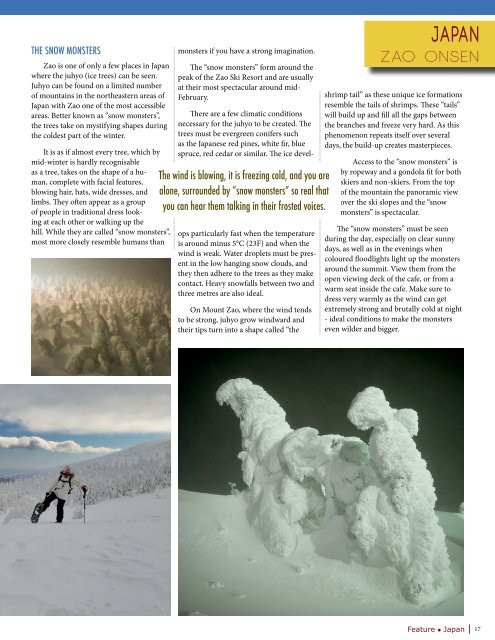GlobeRovers Magazine, Dec 2019
GLOBEROVERS MAGAZINE IS NO LONGER ALLOWED TO HAVE MORE THAN 3 ISSUES ON YUMPU UNLESS WE PAY (to provide revenue-generating content to Yumpu!!) SO PLEASE SEE ALL OUR ISSUES FOR FREE ON THESE MAGAZINE PLATFORMS: CALAMEO, MAGZTER, AND ON THE FREE "globerovers" APP.
GLOBEROVERS MAGAZINE IS NO LONGER ALLOWED TO HAVE MORE THAN 3 ISSUES ON YUMPU UNLESS WE PAY (to provide revenue-generating content to Yumpu!!) SO PLEASE SEE ALL OUR ISSUES FOR FREE ON THESE MAGAZINE PLATFORMS: CALAMEO, MAGZTER, AND ON THE FREE "globerovers" APP.
You also want an ePaper? Increase the reach of your titles
YUMPU automatically turns print PDFs into web optimized ePapers that Google loves.
THE SNOW MONSTERS<br />
Zao is one of only a few places in Japan<br />
where the juhyo (ice trees) can be seen.<br />
Juhyo can be found on a limited number<br />
of mountains in the northeastern areas of<br />
Japan with Zao one of the most accessible<br />
areas. Better known as “snow monsters”,<br />
the trees take on mystifying shapes during<br />
the coldest part of the winter.<br />
It is as if almost every tree, which by<br />
mid-winter is hardly recognisable<br />
as a tree, takes on the shape of a human,<br />
complete with facial features,<br />
blowing hair, hats, wide dresses, and<br />
limbs. They often appear as a group<br />
of people in traditional dress looking<br />
at each other or walking up the<br />
hill. While they are called “snow monsters”,<br />
most more closely resemble humans than<br />
monsters if you have a strong imagination.<br />
The “snow monsters” form around the<br />
peak of the Zao Ski Resort and are usually<br />
at their most spectacular around mid-<br />
February.<br />
The wind is blowing, it is freezing cold, and you are<br />
alone, surrounded by “snow monsters” so real that<br />
you can hear them talking in their frosted voices.<br />
There are a few climatic conditions<br />
necessary for the juhyo to be created. The<br />
trees must be evergreen conifers such<br />
as the Japanese red pines, white fir, blue<br />
spruce, red cedar or similar. The ice develops<br />
particularly fast when the temperature<br />
is around minus 5°C (23F) and when the<br />
wind is weak. Water droplets must be present<br />
in the low hanging snow clouds, and<br />
they then adhere to the trees as they make<br />
contact. Heavy snowfalls between two and<br />
three metres are also ideal.<br />
On Mount Zao, where the wind tends<br />
to be strong, juhyo grow windward and<br />
their tips turn into a shape called “the<br />
JAPAN<br />
ZAO ONSEN<br />
shrimp tail” as these unique ice formations<br />
resemble the tails of shrimps. These “tails”<br />
will build up and fill all the gaps between<br />
the branches and freeze very hard. As this<br />
phenomenon repeats itself over several<br />
days, the build-up creates masterpieces.<br />
Access to the “snow monsters” is<br />
by ropeway and a gondola fit for both<br />
skiers and non-skiers. From the top<br />
of the mountain the panoramic view<br />
over the ski slopes and the “snow<br />
monsters” is spectacular.<br />
The “snow monsters” must be seen<br />
during the day, especially on clear sunny<br />
days, as well as in the evenings when<br />
coloured floodlights light up the monsters<br />
around the summit. View them from the<br />
open viewing deck of the cafe, or from a<br />
warm seat inside the cafe. Make sure to<br />
dress very warmly as the wind can get<br />
extremely strong and brutally cold at night<br />
- ideal conditions to make the monsters<br />
even wilder and bigger.<br />
Feature • Japan | 17





